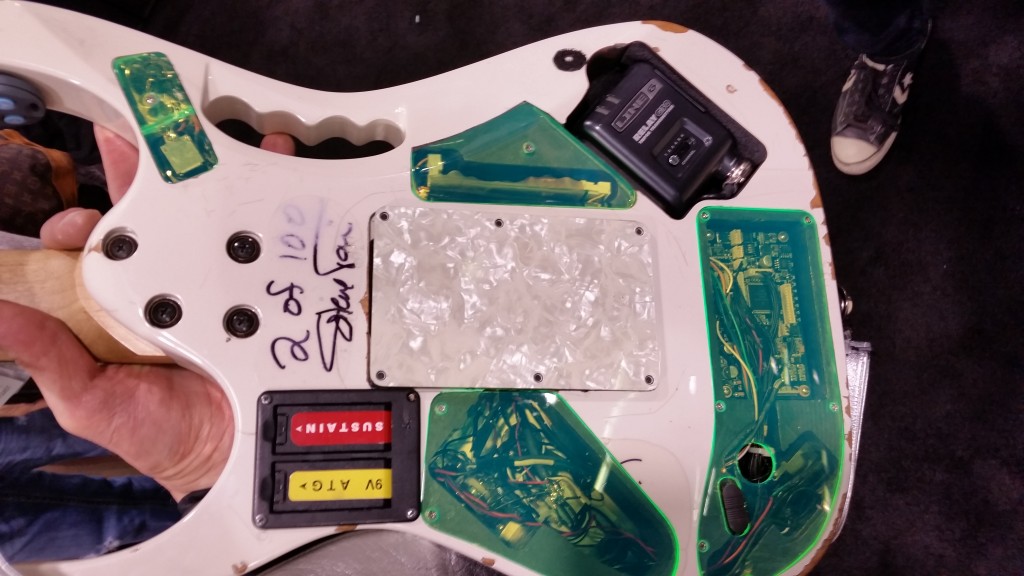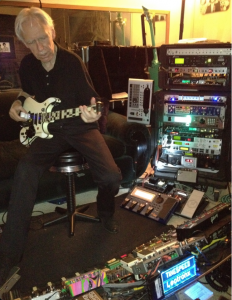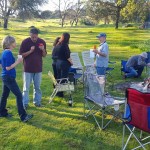Burning Electric Wheels on Auto-Tuned Horseless Carriages
“Fercrissake Fry, don’t be such a friggin’ luddite. Think of what your competition is doing.” The voice is my own, the words flitting through my head in the background of the unbridled chaos and cacophony of the 2016 L.A. NAMM show melee, where Thomas Nordegg and Don Ramsay have just handed me a guitar that compares to everything else I’ve ever played about like a Formula One racer compares to a ’67 Mustang. These two men are high-profile guitar design luminaries, whose work is responsible for much of Steve Vai’s ground-breaking technological abilities; I thought my custom Strat was high-performance tech, but this axe they’ve handed me flies, dives underwater, fires lasers, gathers intel from orbit, cooks food, controls world politics remotely at 2.4 GHZ and foresees my creative ideas based on its telepathic reading and interpretation of my dreams. It plays incredibly well, it’s bewildering, titillating, disturbing, enthralling, liberating and it dares me to even try to find its limits.
The guitar is a Steve Vai weapon named Samoht; it has what I thought was highly-customized, prototypical madness you can’t just buy off the shelf, but it turns out that most of this stuff is (more or less) on the market. I also played Evo II and a brand-new build (same design) for Richie Sambora, who hadn’t even seen or played it yet himself. All this was happening at the Bogner booth, where I found myself the focus of a small scrum of people and the ubiquitous, ever-present cell phone cameras recording me, immutably and for all time, as I haplessly floundered with this bewildering technology while plugged into a well-heeled Ecstasy. Here’s what these lovely beasts have on board:
*************************
1) The Ramsay Linear Tremolo, which is going into production and will be available soon. It’s a major revolution in guitar tremolo design, solving several inherent tremolo issues we’ve had to suffer along with our whole lives. More on this amazing bridge below.
2) Antares Auto-Tune for Guitar (created by Dr. Andy Hildebrand and master luthier Henrik Bridger) will shift up or down chromatically (“Capo Mode”), to an octave above or below; it will change your tuning to Drop D, Open D, Open G, Open E, 12-string or Standard Tuning, every chord you play being turned into natural-sounding but perfectly-tempered bliss, all without touching the tuners. Bends, vibrato and tremolo use is unaffected and completely normal. This pitch-shifting is multi-timbral and polyphonic, each string being processed independently, transparently and with no lag, coming out the guitar’s audio output (1/4″ or 13-pin) just like its normal sound. Exit ‘digital mode’ and auto-tune goes away; your guitar is a normal guitar again.
3) Sustainer System by Fernandes: This is already on the market, so you might already be familiar with it: It’s an electromagnet that lives under the strings in the neck single-coil position and makes them feed back like an e-bow; you can tweak how heavily, and which harmonics it ‘attracts’. Pretty dang cool.
4) Revpad: This is a really cool kidney-shaped touchpad that velcros to your guitar and reads your fingertips for X,Y and Z axis control of an accompanying multi-FX unit. Wireless, 2.4GHZ, range 65 feet. Cool sounds, new possibilities. Check out some of the vids HERE.
5) Steinberger Gearless 40:1 Tuners: These are also on the market already and MAN, they’re nice. Going on my next build for sure. And I’d be remiss not to include the following info from Don Ramsay—if for no other reason than it’s a great little window into an engineer’s mind—he points out that the 40:1 number isn’t actually a ratio: “The worm gear tuners do have a ratio. The Steinberger simply uses a common fine micrometer thread of 40 threads to the inch, or .025″ of barrel travel per revolution. A comparison (of actual string travel) with geared tuners takes measuring the post diameter x pi (3.14156) = travel of one “wrap” divided by the worm gear ratio. For example, a .187″ diameter post = .587 string travel per turn of the post divided by the gear ration (i.e.: 18:1) = .0326″ string travel per turn on the tuner key.”
Got that?
Good.
6) Trev Wilkinson ‘Jeff Beck’ Roller nut: Oh, HELL YES. A headstock that stays in tune with pretty heavy use of the whammy. On my next build for sure. Hard to find, as Trev evidently doesn’t make them anymore, but I think I have a line on ’em…because I’m in the band and I’m nice to animals.
7) TimeSpeed Lectronix Accelerometer Power Switch for guitars with active electronics (not actually on these axes yet, but coming soon as part of TimeSpeed Lectronix Guitar Components) that turns the guitar off two minutes after you set it down, powering back up the instant it’s moved. Same tech as in the Line6 wireless transmitter (which is set neatly into a cavity in the back of the guitar).
*************************
My exposure to and indoctrination into all of this was thanks to my having recently made the acquaintance of the aforementioned Don Ramsay, a very gentlemanly, unassuming, soft-spoken mechanical genius, who in turn introduced me to Thomas Nordegg, the mad genius behind some very audacious guitar-techery. Thomas, Don and Steve Conrad (the most knowledgeable guy alive for guitar electronics, according to Don) kept feeding me hi-tech weaponry at the Bogner booth, ceaselessly flipping switches and changing sounds as I played, from various open tunings, to bass, to 12-string acoustic, to a piccolo mating with a canary. I was so far outside my comfort zone I couldn’t even see it from where I was.
In my world at least, these guys occupy the headwaters of the guitar invention river and the tip of the spearhead. They have such a healthy and complete disregard for tradition, just to be around them I have to re-evaluate what is and isn’t sacred between me and my instrument, and in a broader context, humankind’s relationship with technology. This last is of course a long-standing area of concern for me; I’m writing this piece as much to define my new personal boundaries as anything else. That said, let’s introduce the players and set the stage:
As I said, Don Ramsay is a mechanical genius. His Linear Tremolo design (going into production NOW and, I suspect, about to become the next big thing) employs a moveable fulcrum point, above which the rocking motion of the tremolo arm is transformed—magically, it seems—into smooth, frictionless, linear, planar motion of a non-rocking bridge plate, along the longitudinal axis of the strings. It’s quite insane. Depending on how you have it set up, its motion can be as gentle as a Bigsby or more aggressive than a Floyd. It’s just crazy cool. It gets great tone unplugged and plays like a dream, returning much more completely to pitch from above or below than physics would allow any conventional (rocking) tremolo to do. Also, because there’s no rocking motion, if you’re riding the bridge a bit heavily with your right hand, it won’t go sharp! Despite—no, because of—how strongly opinionated I am about the sacred relationship between bridge, strings and body, and despite how resistant I am to any change to that relationship, the Ramsay Linear Tremolo will be on my next build for sure, as well as all subsequent builds that employ a trem.
You can see a vid of me demoing the bridge HERE.
Thomas Nordegg’s genius, on the other hand, is the mad electronic wizard type; he is immediately imaginative, irreverent and audacious. If he wasn’t applying his buzzing, boundless energies to forwarding the technology of electric guitars, he might have a job in a secret R&D lab somewhere, designing cell phones that can train dogs or a way to upload knowledge into the human brain like so much software—remotely and wirelessly, of course, at 2.4 GHZ, because who has time to wait around for bluetooth speeds? In his world time is speed, hence the name of his company, TimeSpeed.
Thomas’s professionalism makes it impossible for him to ever supply anything—ANYTHING—but the absolute latest, greatest and most advanced tech to his clients and their guitars. If it doesn’t work perfectly at all times, it goes right out the window in ongoing defense against any degree, whatsoever, of errant technology. You may laugh, but it’s a serious thing at the top: besides Steve Vai and Richie Sambora, his technological audacity has enabled Frank Zappa, Dweezil Zappa, Steve Lukather, Jimmy Page, Yngwie Malmsteen and several other luminaries to push the envelope like so many test pilots carving vapor trails across the sky with some extremely unlikely and unique noises—as well as visual weaponry like guitar-mounted lasers and the like—much to the delighted amazement of the civilized world and every guitarist in it. Before it even occurs to the manufacturers to debate whether or not something is possible or affordable, whether it makes sense or is ethically right or whether it’s maybe just too audacious for the world to accept, Thomas has already put it on a guitar, on a pedal board or in a rack, tweaked it until it works better than anything that has gone before it and placed it in the right hands to blow minds and raise the bar.
So, we have a mechanical genius and an electronics genius, to whom no design is sacred except the best one currently achievable. Their skill sets naturally make for a nice separation of labor, so they make a good team. And it has become my happy honor to help them dial things in and provide feedback on new technology before they actually go into production and / or put the guitar into the hands of the big-name clients. So here am I, a guinea pig having fallen in with these two mad scientists, having been to Thomas’s pad several times now and worked with Don on one small suggestion for the Linear Trem, all the while wrestling with my time-tested paradigms and rules regarding what is and isn’t sacred where guitar meets technology.
And they don’t bend easily, my rules. They are stout rules, venerable and well-founded, every technological preference of mine having a lifetime of experiences backing it up, so this promises to be an interesting process. With all that said, let’s put my time-tested paradigms up against the forces and abilities of progress, like so many stodgy, traditionally-minded elderly gentlemen harrumphing over cigars and brandy, facing a squad of millennial athletes in wing-suits. Let’s see who wins…here we go:











No Comments